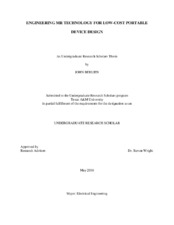| dc.description.abstract | Magnetic Resonance Imaging is an invaluable tool used in many fields, and is a mainstay of medical imaging. Conventional MRI scanners are impractical to move and prohibitively expensive, weighing thousands of pounds and costing upwards of a million dollars. Thus, conventional approaches to MRI may be limiting the applications of this important technology. It is possible, using rare-earth magnets (FeNdB), to create a lightweight, portable, and low cost magnet suitable for Nuclear Magnetic Resonance (NMR) and MRI. We have developed two prototype magnets, using the concept of a Halbach array and the NMR-MANDHALAS method described by Peter Bluemler et al. Constructed of 3D-printed parts and identical cubic magnets, the prototypes have a 0.27 T field with a 5 mm spherical region of approximately 300 parts-per-million (ppm) homogeneity and a 0.18 T field with a 5 mm region of 2000 ppm before shimming. Relatively easy to assemble and safe for handling, these prototype magnets have the potential to enable portable MRI and other Magnetic Resonance experiments. | en |


